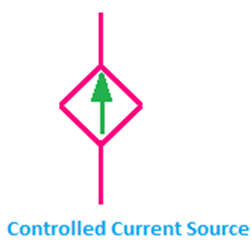- A current source is an electronic circuit that produces or absorbs an electric current that is unaffected by the voltage across it.
- A current source is the polar opposite of a voltage source. Sources fed from a negative voltage supply are sometimes referred to as current sinks. The schematic symbol for an ideal current source driving a resistive load is shown in Figure 1. There are two varieties. A constant current is delivered by an independent current source (or sink). A dependent current source produces current that is proportional to another voltage or current in the circuit.

- When a power supply unit drives a load, there are two possible modes of operation: constant voltage (CV) mode operation and constant current (CC) mode operation.
- In CV mode, the power supply maintains a constant output voltage while changing the output current to match the load resistance. The best example is your 5V USB port, where the output voltage is fixed at 5V but the current varies depending on the load. When you connect a small led, it draws less current, and when you connect a larger one, it draws more current, but the voltage across the LED is always 5V.

- In CC mode, an ideal current source power supply maintains a constant output current while varying the output voltage to match the load resistance. A 12V battery charger in CC mode, where the charging current is fixed but voltage is variable, is an example of this. If you connect a 1A 12V battery charger to a 10.5V battery, the output current will always be 1A, but the output voltage will vary to maintain this 1A charging current. This is where constant current circuits come in handy; another example is a constant current LED driver circuit, in which the current flowing through an LED must be constant.
- The graph below depicts the current generated by a constant current source.
![]()
- Despite changes in voltage or resistance, the current remains constant throughout.
Transistor Active Constant Current Source Basics
- The simple use of a transistor allows for the creation of a far more effective current source with only a few additional electronic components such as a transistor, some resistors, and a few simple equations for the electronic circuit design.
- Because the collector current in a transistor circuit is B times the base current, the current source operates. This is independent of the collector voltage, as long as there is enough voltage in the collector to drive the current through the load device.
![]()
- The collector current in this circuit is times the base current. Normally is large, so the emitter current, which is ( + 1) times the base current, and the collector current, which is times the base current, is assumed to be the same.
- In light of this, designing a circuit for a given current is a simple task.
Ie = (β + 1) Ib
Iload =Ic =βIb
Iload = β Ve(β + 1) Re
Iload =Vb − 0.6Re
- The base voltage can be set by adjusting the resistors R1 and R2. Assuming a silicon transistor, the emitter voltage will be 0.6 volts lower. With a basic understanding of Ohms law and the emitter voltage, it is possible to calculate the emitter current.
How does a Transistor Maintain a Constant Current?
- As with diodes, this question can be specifically answered by considering the processes in the semiconductor device. However, it would be interesting to explain this on a conceptual level by revealing the fundamental concept. As previously stated, this “philosophical” approach has several advantages: first, it does not necessitate extensive knowledge of semiconductor devices; second, it applies to all 2-terminal devices with this property. I’ll do so by employing the concept of “dynamic resistance.”
- In general, a transistor acts like a resistor, interfering with current and causing a voltage drop and heat loss. This “resistor” has a relatively constant low resistance in the initial steep part of its output IV curve. If it were a true resistor, the curve would continue in the same direction.
- When the current threshold of the respective transistor is reached (determined by the base-emitter voltage or current), the slope of the curve changes and becomes almost horizontal. The voltage is still changing, but the current is no longer changing. Why?
- When the voltage V increases, the transistor’s static resistance R increases at the same rate. As a result, the current through the transistor I = V/R remains constant.
- This is a simple arithmetic trick in which we change the numerator and denominator of a fraction in the same direction and at the same rate; as a result, the division quotient remains constant.
- Thus, by changing its resistance in the same direction as the current, this “dynamic resistor” maintains a constant current.
Applications of Active Transistor Constant Current Source
- As a load for a transistor or vacuum tube gain element, a constant current source is used. The voltage gains from this implementation are extremely high, far exceeding those achievable with a resistive load.
- Another application is for a signaling circuit where the interconnection’s intervening resistance is variable or unknown. This is how ‘Teletype’ signaling circuits were built. This method is still used in a variety of industrial control applications.
- A third was a series circuit for area street lighting. Because it used an arc lamp, the starting voltage had to be extremely high. The current would remain constant as the voltage across each lamp fell as the arc began.
Applications of Active Transistor Constant Current Source
In portable devices, battery charging circuits use constant current sources. A small list of applications where a constant current source is used is listed below.
- Amplifier system.
- Solar systems.
- Electromagnets.
- Motor system for steady speed.
- Hall Effect sensors.
- Regulator circuits to bias more zener diodes.
- A constant current source can also be used for various purposes, such as regulating the bias of an integrated circuit’s operational parameters, particularly in linear circuits.
